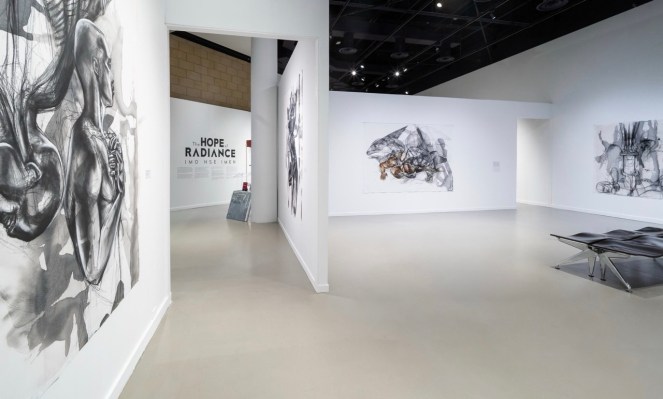For many startups, getting a spot in an accelerator program like Y Combinator or TechStars is like winning the golden ticket to Willy Wonka’s chocolate factory. Accelerators offer a wealth of opportunities that can make the difference between a great idea that doesn’t achieve its potential and one that leads to an IPO.
We’re accustomed to seeing accelerators work for companies disrupting travel, payment processing or cloud storage, but what if that model could work outside the ambit of the VC mill? What if a little bit of investment, a splash of mentoring and practical support, a slew of introductions, and a whole lot of belief could be used to help artists with their careers?
That’s exactly what Inversion Art is trying to do.
“Y Combinator changed my life,” Joey Flores, co-founder of Inversion Art, told TechCrunch. “I feel so much gratitude for the program, and I thought that if I could do something like that for artists, it would be amazing.”
Flores is a Y Combinator alumnus whose music-marketing platform EarBits graduated from the program in 2010 and was sold in 2015. While Flores isn’t a professional artist, art is a deeply important part of his life, and a chance comment by a VC in a 2020 conversation set him on the path to find a way to support artists who have the drive and passion to make art their lifelong careers but need help to achieve it. As part of his research, he connected with his co-founder Jonathan Neil, and together they are looking to change the way that artists find success and recognition.
“The artist has always relied on other parties such as collectors, museums and galleries to develop their careers and define success for them,” said Neil. “We are, in our opinion, the first organization that is really sitting on the same side of the table as the artist in all of their negotiations and activities and really helping them to define success for themselves.”
Inversion Art’s accelerator program is opened up twice a year to 15 artists from anywhere in the world. It’s a low-residency scheme, and the cohorts come together in Los Angeles for the first and last 10 days of the three-month program. During the residential period, the artists mingle, meet their liaisons who will provide them with practical support or artists’ services for the next five years, and network with members of the arts community who could promote, champion, and assist them with their careers. It culminates in an equivalent of demo day: an invite-only, end-of-program exhibition.
Inversion Art supports its cohort in two ways. First, it buys work previously produced by the artist at 30% of the artist’s previous year’s income, up to $100,000. The artist gets cash and Inversion Art acquires a collection that, with good luck and tailwinds, should accumulate in value as its groups of artists grow in stature. Second, it takes a 15% cut of any sales made by the artists in the five years following their graduation from the program.
“We’re providing support even when there’s no revenue coming into the studio,” said Neil. “But when there’s big revenue coming in, we’re sharing at 15%. So it evens out for us.”
Just as Y Combinator is wildly competitive, Inversion Art has stringent criteria for joining its program. “When it comes to investing in artists, we’re looking for artists with big ambitions,” said Flores. “And obviously, the quality of the work is paramount.”
An artist’s traction could be judged by their art hitting particular price points, or if they’ve made a certain value; pieces could have been exhibited in vaunted exhibitions or made it into collections. It’s not very different from being a startup founder: You have to have your natural flair backed up by staying power and determination.
But one area in which artists are sometimes different is where Flores and Neil are keen to bring all the support they can: Advocating for themselves.
“Artists have this sort of allergic reaction to advocating for their own work, and pricing it and balancing it in the right way,” said Flores. “I know very much how artists don’t want to deal with the business side of what they do.”
To address this, the accelerator program includes five years of artist services provided by a dedicated artist liaison. These services include helping the artists establish a legal entity and separate banking for their creative practice, as well as assistance with payroll, billing, accounts and tax, healthcare and pension, marketing management, inventory support, and basic legal services.
Artists don’t have to be a part of the accelerator to sign up for these services. Flores and Neil describe it as a back-office management platform for creative professionals. They’re starting with fine artists, but it could extend into commercial artists, designers and even architects.
Offering two different elements in one business might feel like a risk, but Flores feels those aspects coexist in a mutually supportive environment, saying that providing one without the other wouldn’t be as useful.
“If we wanted to build just the accelerator program without the services division, we’d have a lot of artists who are hamstrung by their own operations, and we wouldn’t do a very good job as an investment company,” said Flores. “And if we built just a services division for artists, no matter how much we explain ourselves as a managed solution, we’d have to go out and spend a ton on marketing or building a sales team.”
While the Inversion Art team recognizes that it won’t be operating on the same scale as, say, Y Combinator, it thinks the support platform will be quite valuable for artists in need of an organizational solution and for providing the firm with turnover.
But ultimately, art is much like VC: You only need to find one megastar. “If you could make a painting in 20 hours that would sell for $20,000, wouldn’t you wonder why there are no funding opportunities in your market?” Flores asks.
